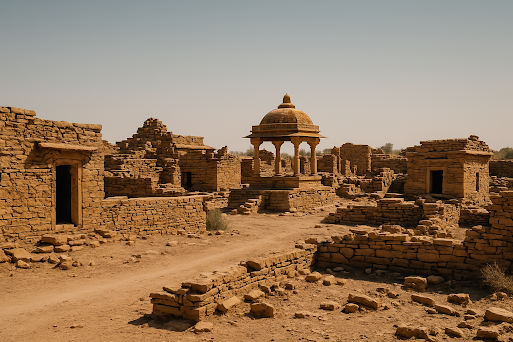✨ Step Back in Time: Unearthing the Magic of Ajanta Caves ✨
Imagine a place carved by hand into the very heart of a mountain, where ancient stories still whisper from the walls. Welcome to the Ajanta Caves, a breathtaking collection of 30 rock-cut wonders nestled in Maharashtra's serene Sahyadri Hills. These aren’t just old caves; they’re a vibrant gallery of India’s Buddhist past, a UNESCO World Heritage Site, and a testament to timeless creativity and devotion.
🎨 Where Stone Comes Alive: Art That Breathes Across Centuries
Stepping into the Ajanta Caves feels like entering a living time capsule. Even after 2,000+ years, the vivid murals pulse with life, color, and sacred stories. These masterpieces depict the Jataka tales – stories from the Buddha's past lives – and the intricately painted ceilings could rival any European fresco.
🐅 A Tiger Hunt & A Lost World Found:
While the locals were always aware of Ajanta’s presence, it was Captain John Smith, a British officer out on a tiger hunt in 1819, who stumbled upon the entrance and reintroduced it to the world. In true colonial fashion, he even etched his name and date into one of the precious murals – a controversial act that ironically became part of the site's history.
⏳ Two Eras, One Timeless Legacy:
Ajanta wasn’t built all at once. Its construction spanned two distinct periods, each leaving behind its own artistic and spiritual footprint.
📜 1. The Early Phase (2nd century BCE – 1st century CE)
-
Caves: 9, 10, 12, 13, 15A
-
Style: Hinayana Buddhism
-
Features: Simple chaityas and monastic cells, adorned with early murals illustrating Jataka stories.
-
Patron: The Satavahana dynasty
📜 2. The Golden Phase (460–480 CE)
-
Caves: 1–8, 11, 14–29
-
Style: Mahayana Buddhism
-
Features: Rich sculptures and vibrant murals of the Buddha, bodhisattvas, and celestial beings.
-
Patron: King Harishena of the Vakataka dynasty
✨ Stories Painted in Stone: A Visual Feast:
Some caves are true visual poetry. Make sure to explore:
-
Cave 1 & 2: Striking depictions of Bodhisattvas and palace scenes.
-
Cave 16 & 17: The legendary Jatakamala illustrations by Aryasura.
Each mural tells a story of compassion, sacrifice, and enlightenment, inviting you to pause, reflect, and admire the devotion of ancient artists.
🗺️ Finding Ajanta: Your Journey to the Past:
-
59 km from Jalgaon
-
104 km from Chhatrapati Sambhajinagar (formerly Aurangabad)
-
350 km from Mumbai
-
100 km from Ellora Caves
✈️ How to Reach:
-
By Air: Fly into Jalgaon or Chhatrapati Sambhaji Nagar.
-
By Train: Nearest stations are Jalgaon and Bhusawal.
-
By Road: Accessible via regular bus or taxi services.
🌄 Many travelers combine Ajanta with a visit to Ellora Caves and Elephanta Island, completing an epic rock-cut adventure.
📜 Echoes of History: A Legacy That Lives On
Though Buddhist patronage faded by the 6th century, Ajanta’s fame endured. It’s mentioned in the writings of Chinese traveler Xuanzang and even in Ain-i-Akbari, a 16th-century Mughal document.
Today, Ajanta stands not only as a monument of faith and art but as a beacon of India’s cultural identity. Preserved by the Archaeological Survey of India, the site continues to draw scholars, artists, and wanderers from around the globe.
🙏 Your Turn: Have You Felt the Magic of Ajanta?
Whether you’re a lover of history, art, or just seeking a soulful travel experience, the Ajanta Caves offer something unforgettable. Every sculpture, every pigment, and every shadow tells a story of devotion, imagination, and timeless creativity.
💬 Have you explored Ajanta? Share your experience, photos, or questions in the comments below — let’s keep the legacy alive! 🌿
🔑 TL;DR – Important Highlights:
-
📍 Location: Aurangabad, Maharashtra
-
🏆 UNESCO World Heritage Site: Since 1983
-
🕉️ Religion Represented: Buddhism (Hinayana & Mahayana)
-
🕰️ Time Periods: 2nd century BCE and 5th century CE
-
🎨 Famous For: Stunning murals, rock-cut sculptures, chaityas (prayer halls), and Jataka tales
-
🧭 Nearby Attractions: Ellora Caves, Elephanta Island, Daulatabad Fort





Comments
Post a Comment